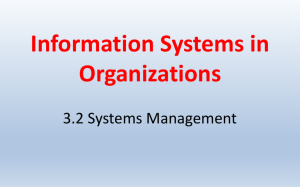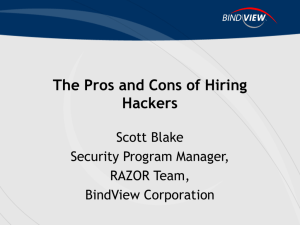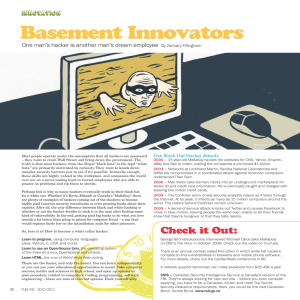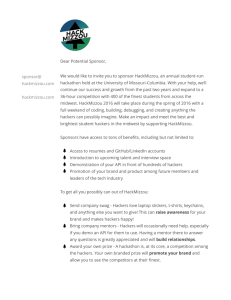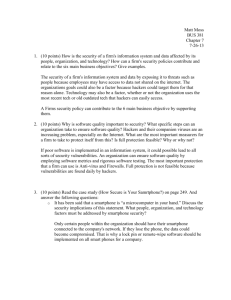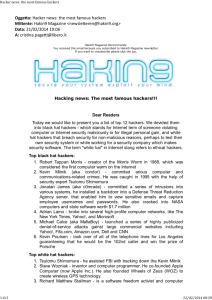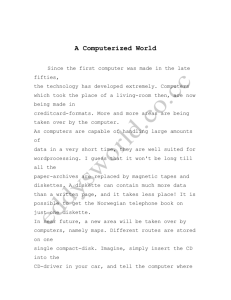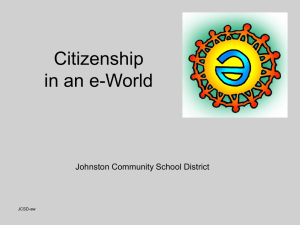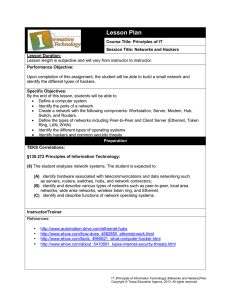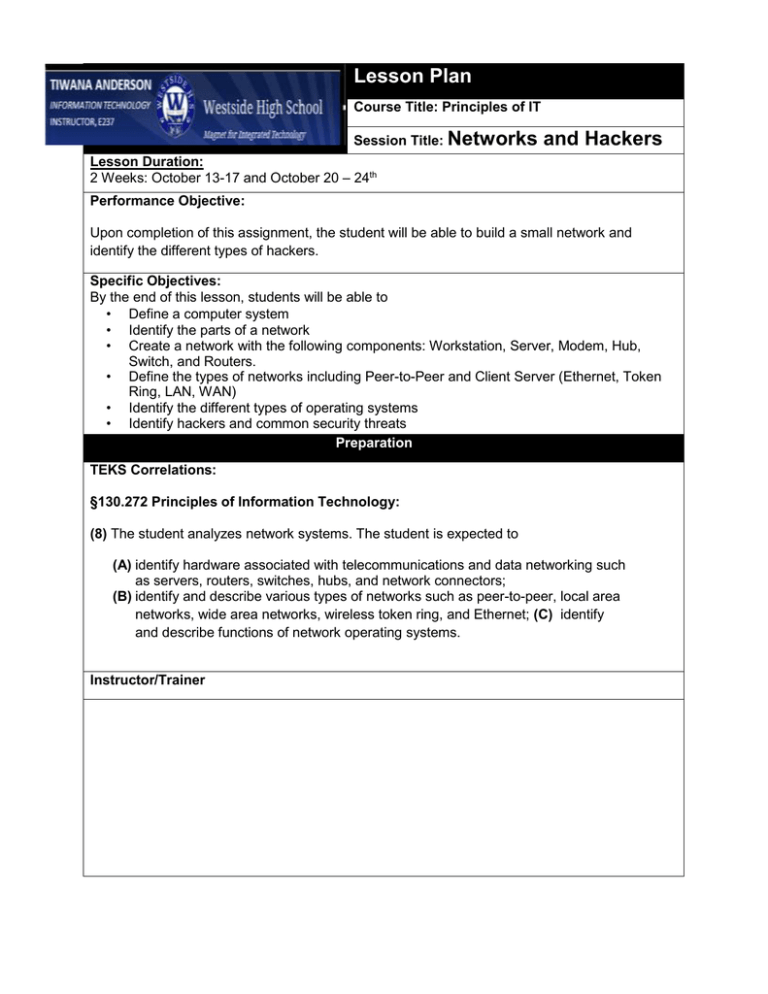
Lesson Plan
Course Title: Principles of IT
Session Title: Networks
and Hackers
Lesson Duration:
2 Weeks: October 13-17 and October 20 – 24th
Performance Objective:
Upon completion of this assignment, the student will be able to build a small network and
identify the different types of hackers.
Specific Objectives:
By the end of this lesson, students will be able to
• Define a computer system
• Identify the parts of a network
• Create a network with the following components: Workstation, Server, Modem, Hub,
Switch, and Routers.
• Define the types of networks including Peer-to-Peer and Client Server (Ethernet, Token
Ring, LAN, WAN)
• Identify the different types of operating systems
• Identify hackers and common security threats
Preparation
TEKS Correlations:
§130.272 Principles of Information Technology:
(8) The student analyzes network systems. The student is expected to
(A) identify hardware associated with telecommunications and data networking such
as servers, routers, switches, hubs, and network connectors;
(B) identify and describe various types of networks such as peer-to-peer, local area
networks, wide area networks, wireless token ring, and Ethernet; (C) identify
and describe functions of network operating systems.
Instructor/Trainer
Instructional Aids and Weekly Lessons:
•
•
•
Networks and Hackers Presentation CONTINUE – MONDAY & TUESDAY
QUIZ: Networks and Hackers Notes for the Presentation WEDNESDAY/ THURSDAY
QUIZ REVIEW: Lab Assignment (KAHOOTS.IT) ON HACKING; - FRIDAY
Materials Needed:
• Instructional aids
• Paper for students to draw on
• Color pencils, markers, and/or crayons to draw with
• Flash cards for students to create review materials
Equipment Needed:
• Projector for teacher computer
Learner
• This is an introduction on networks and hackers for students. No previous knowledge is
needed.
Introduction/
MODIFICATIONS AND ACCOMODATIONS
MI
Introduction (LSI Quadrant I):
SAY, “How many of you have ever logged onto a computer at school, the library,
or a home office with more than one computer?”
ASK, “Have you ever wondered how it all works?”
Outline
MI
Outline (LSI Quadrant II): Teachers can use the
Networks and Hackers Presentation and Handout and
Lab.
Instructor Notes:
I.
Hand out the Teen Hacker Article Handout
to the students to read.
I.
II.
Hand out the Networks and Hackers Notes
Handout or advise students to take notes
during the presentation.
II.
IT: [Principals of Information Technology]: [Networks and Hackers] Plan
2013. All rights reserved.
Hand out this article
for the students to
read for homework
ahead of this lesson.
Hand out copies of
the Network and
Hacker Notes to each
student, or you can
advise each student
to get ready to take
notes.
Copyright © Texas Education Agency,
III.
Show the presentation, which covers
the following concepts:
a. Computer system
b. Parts of a network
I. Workstation
ii.
Server Iii.
Modem iv. Hub
V. Switch vi.
Router
C. Types of networks
I. Peer-to-peer ii.
Client server
1. Ethernet
2. Token ring
3. Lan
4. Wan
d. Operating systems
e. Hackers
F. Security threats
III.
Students should be
taking notes as you
are showing the
Networks and
Hackers
Presentation.
IV.
Hand out the Lab Assignment to students. They
will create diagrams of the networks based on
seniors listed.
IV.
Students should
draw out 3 different
types of networks
listed on the Lab
Assignment. Have
them create a
legend for the
different parts of the
network they are
trying to draw – like
a box with the word
Router for a router.
Work through the SOHO portion of the lab
together – the key listed is one of many
solutions.
VI.
Work through the
SOHO setup as a
class so that
students
understand what
you are looking for.
V.
IT: [Principals of Information Technology]: [Networks and Hackers] Plan
2013. All rights reserved.
Copyright © Texas Education Agency,
VII.
Student groups need to finish up the Lab
Assignment.
VIII.
Review for Networks and Hackers Quiz
V.
VI.
Divide students into
groups of two or
three. Have them
complete the Lab
Assignment for the
small office and
world wide
company.
After completion of
the lab, have
students create
flash cards of the
important terms to
study for the quiz.
Application
MI
Guided Practice (LSI Quadrant III):
Do the SOHO portion of the lab as a class.
MI
Independent Practice (LSI Quadrant III):
Hand out the Lab Assignment. Divide students into groups of two or three. Have each
group work together on the following…
SAY, “Students, now that you see how we have set up a SOHO, see if you
and a partner can come up with one possible solution to the rest of the
problems on the Lab Assignment.”
Summary
MI
Review (LSI Quadrants I and IV):
IT: [Principals of Information Technology]: [Networks and Hackers] Plan
2013. All rights reserved.
Copyright © Texas Education Agency,
SAY, “Now that we have a good understanding about Networks, we need to study for
our quiz. In your groups, each of you needs to create your own set of flash cards to
study. Work together as a group to make sure that you do not miss any important
concepts or terms. I will need to review these to make sure that I feel you are not
missing anything. I would also draw out our SOHO example so that you do not forget
it later.”
Evaluation
MI
Informal Assessment (LSI Quadrant III):
•
•
MI
Teacher will check for understanding while going through the SOHO
portion of the lab as a class.
Review of student-created flash cards
Formal Assessment (LSI Quadrant III, IV):
•
•
Completion of the rest of the Lab Assignment done in groups.
Networks and Hackers Quiz WEDENSDAY AND THURSDAY
IT: [Principals of Information Technology]: [Networks and Hackers] Plan
2013. All rights reserved.
Copyright © Texas Education Agency,
Icon
MI
Modification
Teaching Strategies
Personal Development
Strategies
Lecture, discussion, journal
writing, cooperative learning,
word origins
Reading, highlighting, outlining, teaching
others, reciting information
Logical/
Mathematical
Problem solving, number
games, critical thinking,
classifying and organizing,
Socratic questioning
Organizing material logically, explaining
things sequentially, finding patterns,
developing systems, outlining, charting,
graphing, analyzing information
Visual/Spatial
Mind-mapping, reflective
time, graphic organizers,
color-coding
systems,
drawings, designs, video,
DVD, charts, maps
Developing graphic organizers, mindmapping, charting, graphing, organizing
with color, mental imagery (drawing in
the mind’s eye)
Use music, compose songs
or raps, use musical
language or metaphors
Creating rhythms out of words, creating
rhythms with instruments, playing an
instrument, putting words to existing
songs
Use manipulatives, hand
signals, pantomime, real life
situations, puzzles and board
games, activities, roleplaying, action problems
Reflective teaching,
interviews, reflective listening,
KWL charts
Moving while learning, pacing while
reciting, acting out scripts of material,
designing games, moving fingers under
words while reading
Verbal/
Linguistic
Musical/
Rhythmic
Bodily/
Kinesthetic
Intrapersonal
Reflecting on personal meaning of
information, studying in quiet settings,
imagining experiments, visualizing
information, journaling
Studying in a group, discussing
information, using flash cards with
other, teaching others
Interpersonal
Cooperative learning, roleplaying, group brainstorming,
cross-cultural interactions
Naturalist
Natural
objects
as
manipulatives and as
background for learning
Connecting with nature, forming study
groups with like-minded people
Existentialist
Socratic questions, real life
situations,
global
problems/questions
Considering personal
larger context
IT: [Principals of Information Technology]: [Networks and Hackers] Plan
2013. All rights reserved.
relationship
Copyright © Texas Education Agency,
to

